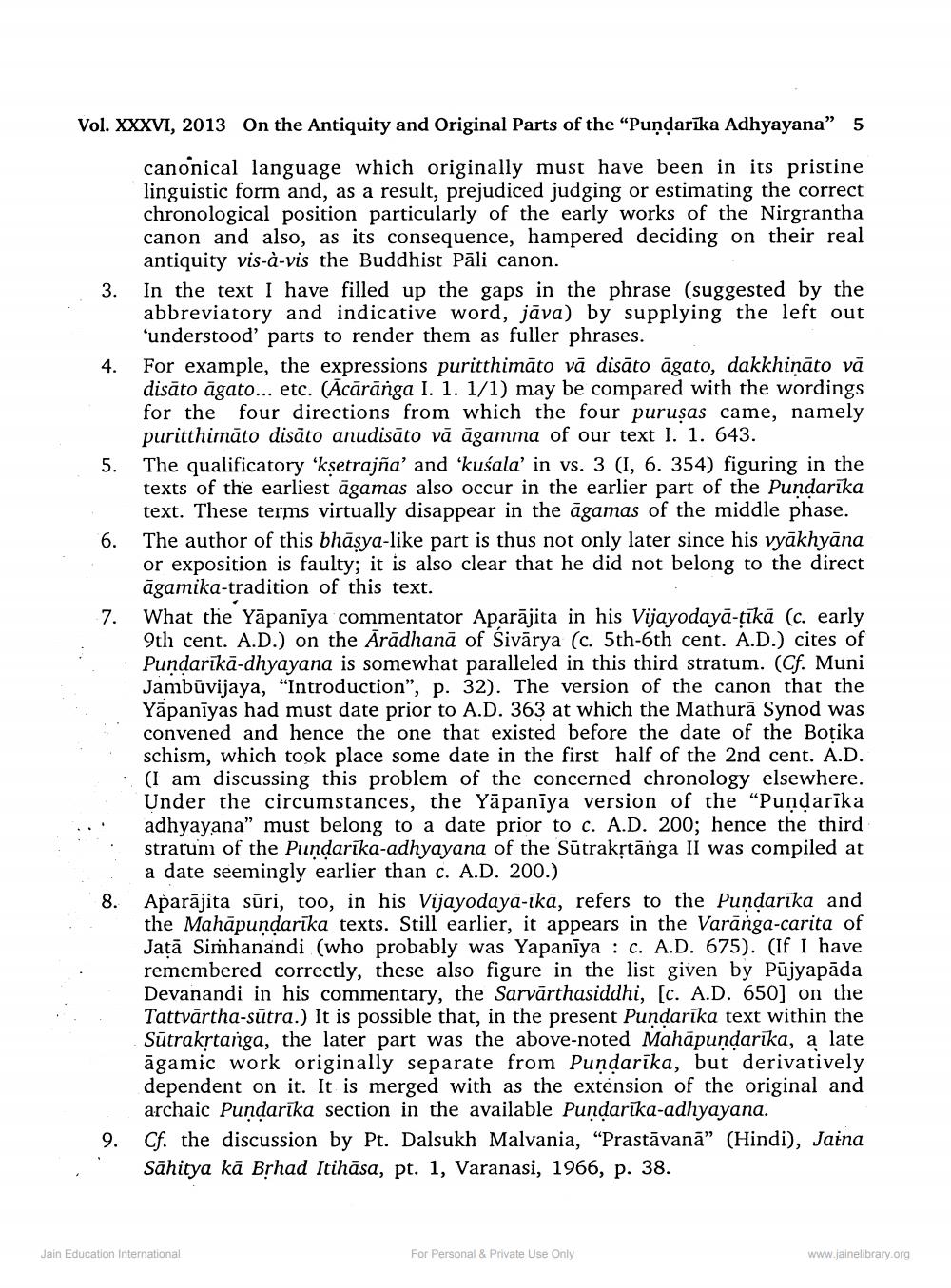________________
Vol. XXXVI, 2013 On the Antiquity and Original Parts of the "Pundarika Adhyayana" 5
canonical language which originally must have been in its pristine linguistic form and, as a result, prejudiced judging or estimating the correct chronological position particularly of the early works of the Nirgrantha canon and also, as its consequence, hampered deciding on their real antiquity vis-à-vis the Buddhist Pāli canon.
3.
4.
5.
6.
7.
8.
9.
In the text I have filled up the gaps in the phrase (suggested by the abbreviatory and indicative word, jäva) by supplying the left out 'understood' parts to render them as fuller phrases.
For example, the expressions puritthimāto vā disāto agato, dakkhiņāto vā disato agato... etc. (Acäränga I. 1. 1/1) may be compared with the wordings for the four directions from which the four purusas came, namely puritthimāto disāto anudisāto vā āgamma of our text I. 1. 643.
The qualificatory 'kṣetrajña' and 'kusala' in vs. 3 (I, 6. 354) figuring in the texts of the earliest ägamas also occur in the earlier part of the Pundarika text. These terms virtually disappear in the agamas of the middle phase. The author of this bhāṣya-like part is thus not only later since his vyākhyāna or exposition is faulty; it is also clear that he did not belong to the direct agamika-tradition of this text.
What the Yapaniya commentator Aparajita in his Vijayodaya-țīkā (c. early 9th cent. A.D.) on the Aradhana of Sivarya (c. 5th-6th cent. A.D.) cites of Pundarika-dhyayana is somewhat paralleled in this third stratum. (Cf. Muni Jambüvijaya, "Introduction", p. 32). The version of the canon that the Yapaniyas had must date prior to A.D. 363 at which the Mathura Synod was convened and hence the one that existed before the date of the Botika schism, which took place some date in the first half of the 2nd cent. A.D. (I am discussing this problem of the concerned chronology elsewhere. Under the circumstances, the Yapaniya version of the "Pundarika adhyayana" must belong to a date prior to c. A.D. 200; hence the third stratum of the Pundarika-adhyayana of the Sutrakṛtānga II was compiled at a date seemingly earlier than c. A.D. 200.)
Aparajita sūri, too, in his Vijayodaya-ikā, refers to the Pundarika and the Mahapuṇḍarika texts. Still earlier, it appears in the Varanga-carita of Jață Simhanandi (who probably was Yapaniya c. A.D. 675). (If I have remembered correctly, these also figure in the list given by Pujyapāda Devanandi in his commentary, the Sarvärthasiddhi, [c. A.D. 650] on the Tattvärtha-sutra.) It is possible that, in the present Pundarika text within the Sūtrakṛtanga, the later part was the above-noted Mahapundarika, a late agamic work originally separate from Pundarika, but derivatively dependent on it. It is merged with as the extension of the original and archaic Pundarika section in the available Pundarika-adhyayana.
Cf. the discussion by Pt. Dalsukh Malvania, "Prastāvanā" (Hindi), Jaina Sahitya kā Bṛhad Itihasa, pt. 1, Varanasi, 1966, p. 38.
Jain Education International
For Personal & Private Use Only
www.jainelibrary.org




